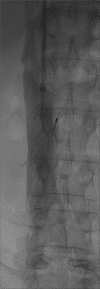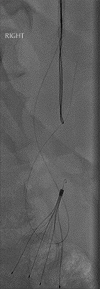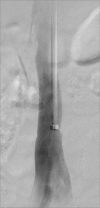A 7-year retrospective review of the technical success of the "low-profile" hangman technique for complicated inferior vena cava (IVC) filter retrievals
- PMID: 32071027
- PMCID: PMC7051261
- DOI: 10.5152/dir.2019.19223
A 7-year retrospective review of the technical success of the "low-profile" hangman technique for complicated inferior vena cava (IVC) filter retrievals
Abstract
Purpose: We aimed to assess the safety and effectiveness of a modified low-profile hangman technique.
Methods: We performed a retrospective review of all filter retrieval procedures performed at a major trauma center, from 2012 to 2019. Records were reviewed for patient demographics, device type, device dwell time, device tilt, embedded hook, success of device retrieval, evidence of caval injury and occurrence of complications.
Results: From 2012 to 2019 there were 473 filter retrieval attempts. An advanced technique was documented in 66 (14%). The low-profile hangman technique alone was documented in 23 procedures (5% of all procedures, 35% of advanced technique procedures). Average screening time was 28 minutes. At the time of retrieval attempt, 9 patients (41%) were anticoagulated. The hangman technique was employed as isolated maneuver in 23 patients and was successful on initial attempt in 22 cases (96%). The average dwell time of filters retrieved by the hangman technique was 228 days (range, 40-903 days; median, 196 days). No procedure-related complications occurred.
Conclusion: The retrieval of IVC filters is an important part of offering an IVC filter service. Advanced techniques to retrieve caval filters are multiple, and the risk of complications is increased in these cases. We demonstrate the safety and effectiveness of a new modified and lower-profile hangman technique. This new technique could be performed with only an 11 French venous access sheath using off-the-shelf equipment and it remains a cost-effective approach to complex filter retrieval.
Conflict of interest statement
The authors declared no conflicts of interest.
Figures






Similar articles
-
Inferior vena cava filter retrievals using advanced techniques: a systematic review.Diagn Interv Radiol. 2023 May 31;29(3):500-508. doi: 10.4274/dir.2022.22908. Epub 2023 Feb 27. Diagn Interv Radiol. 2023. PMID: 36960630 Free PMC article.
-
The hangman technique: a modified loop snare technique for the retrieval of inferior vena cava filters with embedded hooks.J Vasc Interv Radiol. 2015 Jan;26(1):107-10. doi: 10.1016/j.jvir.2014.04.002. J Vasc Interv Radiol. 2015. PMID: 25541448
-
Retrieval of an embedded suprarenal inferior vena cava filter using the Hangman technique.J Med Imaging Radiat Oncol. 2018 Dec;62(6):806-809. doi: 10.1111/1754-9485.12761. Epub 2018 Jul 5. J Med Imaging Radiat Oncol. 2018. PMID: 29974622
-
Inferior vena cava filter retrieval: effectiveness and complications of routine and advanced techniques.J Vasc Interv Radiol. 2014 Jun;25(6):933-9; quiz 940. doi: 10.1016/j.jvir.2014.01.019. Epub 2014 Mar 13. J Vasc Interv Radiol. 2014. PMID: 24630748
-
Inferior Vena Cava Filter Long Term Complications and Retrieval Techniques: A Case Series and Literature Review.Vasc Endovascular Surg. 2024 Jul;58(5):559-566. doi: 10.1177/15385744231226048. Epub 2024 Jan 9. Vasc Endovascular Surg. 2024. PMID: 38196287 Review.
Cited by
-
Single access 2-snare technique: A novel approach for challenging IVC filter retrieval.Radiol Case Rep. 2025 Jul 17;20(10):4989-4993. doi: 10.1016/j.radcr.2025.06.061. eCollection 2025 Oct. Radiol Case Rep. 2025. PMID: 40727902 Free PMC article.
-
Predictors of endobronchial forceps utilization for inferior vena cava filter retrieval: when snare retrieval fails.CVIR Endovasc. 2023 Nov 11;6(1):55. doi: 10.1186/s42155-023-00392-9. CVIR Endovasc. 2023. PMID: 37950835 Free PMC article.
-
Inferior vena cava filter retrievals using advanced techniques: a systematic review.Diagn Interv Radiol. 2023 May 31;29(3):500-508. doi: 10.4274/dir.2022.22908. Epub 2023 Feb 27. Diagn Interv Radiol. 2023. PMID: 36960630 Free PMC article.
-
Ibero-American Society of Interventionism (SIDI) and the Spanish Society of Vascular and Interventional Radiology (SERVEI) Standard of Practice (SOP) for the Management of Inferior Vena Cava Filters in the Treatment of Acute Venous Thromboembolism.J Clin Med. 2021 Dec 24;11(1):77. doi: 10.3390/jcm11010077. J Clin Med. 2021. PMID: 35011826 Free PMC article.
-
Complications Associated With Inferior Vena Cava Filter Retrieval: A Systematic Review.Cureus. 2024 Feb 27;16(2):e55052. doi: 10.7759/cureus.55052. eCollection 2024 Feb. Cureus. 2024. PMID: 38550500 Free PMC article. Review.
References
-
- Al-Hakim R, Mcwilliams J. Retrievable inferior vena cava filter update. Endovasc Today. 2014:23–30. doi: 10.1016/j.ijsu.2015.07.318. - DOI
MeSH terms
LinkOut - more resources
Full Text Sources

